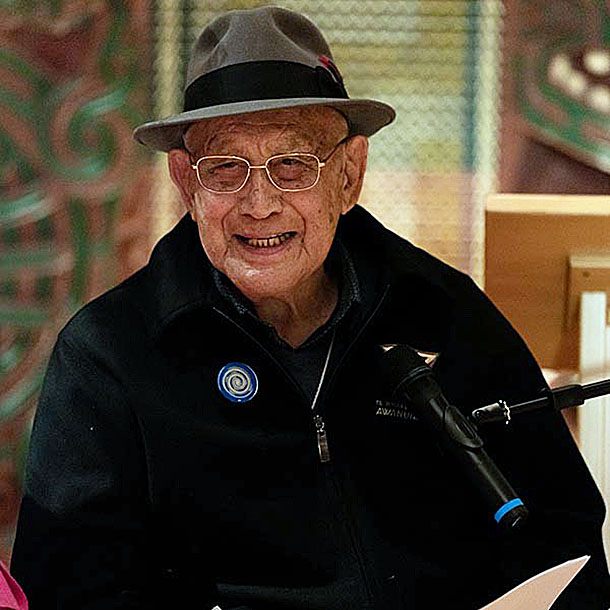Tā Hirini launches book at 98

WRITER IN RESIDENCE: Mātauranga Māori is the first book Tā Hirini has written using a computer.
News Editor
Te Whare Wānanga o Awanuiārangi founder and inaugural Writer in Residence, Tā Hirini Moko Mead, has officially launched his seminal work, the publication Mātauranga Māori.
His whānau, lifelong friends, distinguished guests, and esteemed colleagues, joined him at the special event on Saturday held at Te Mānuka Tūtahi Marae in Whakatāne.
At 98 years old, Tā Hirini is the living embodiment of the knowledge he has committed his life to preserving, revitalising and sharing.
The book, published by Huia Publishers in collaboration with Awanuiārangi, is an important contribution to te ao Māori and the community, and marks the first publication under the Memorandum of Understanding between the two institutions.
In a statement leading up to the launch, he said: “This book is a dream fulfilled. It is informed by every book, paper, and article written across 73 years.”
This release follows Tā Hirini’s bestselling work Tikanga Māori, a text that has become a staple for educators, researchers, and iwi leaders across the motu. Mātauranga Māori builds on that foundation.
Awanuiārangi chairperson Layne Harvey, who authored the foreword of the book, was the first kaikōrero of the day and offered background on Tā Hirini.
“If we pause to reflect, he is probably the most prolific living non-fiction New Zealand author today.
“He was born in 1927, two years before the start of the Great Depression. He knew Tā Apirana Ngata personally, who encouraged him down certain pathways of learning and knowledge.
“Tā Apirana was taught by his father, Paratene, and others, so that is an unbroken line of knowledge, information, encouragement, and support spanning centuries, to a person who is sitting amongst us today, who wrote this book at the age of 98 and a half.
“He grew up in the isolated, rural, Māori communities of Te Teko and Murupara.
“Confiscation for rebellion, and the Native Land Court, had stripped his tribes of their resources on a seismic scale.
“Half a century later, the full effects of the depression began to bite and subsistence living off the land was unremarkable for the time. That was the world Hirini grew up in.”
An academic critique from Professor Rawinia Higgins was sharp, witty, and insightful.
She drew a playful comparison between Mātauranga Māori and The Matrix, describing Tā Hirini as Morpheus guiding us through knowledge and reality.
Awanuiārangi chief executive Professor Wiremu Doherty spoke about the depth of meaning within mātauranga Māori and the importance of protecting it from being misunderstood or taken out of context. He reminded us that real understanding comes through our shared experiences and connections.
Tā Pou Temara also added to the occasion with his own insightful assessments surrounding mātauranga Māori and its application in everyday life.
The final kaikōrero of the day was Tā Hirini, who has authored more than 70 books, papers, and academic articles.
He said, “I have written every book by hand. This is the first book I have written on the computer. And yes, I wrote it – not AI.”
He concluded his kōrero with a waiata he wrote for Mātauranga Māori – Te Wawata, The Dream, performed by Kawata Teepa, who also composed the melody.
Mātauranga Māori is available through Huia Publishers.
